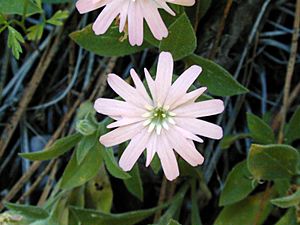Hooker's silene facts for kids
Quick facts for kids Hooker's silene |
|
|---|---|
 |
|
| Scientific classification | |
| Genus: |
Silene
|
| Species: |
hookeri
|
Silene hookeri is a beautiful flowering plant. It belongs to the Caryophyllaceae family, which includes many types of flowers. People know it by several fun names like Hooker's silene or Hooker's catchfly. Other names include Hooker's Indian pink and Hooker's glandular campion.
This plant grows naturally in the mountains of Oregon and northwestern California. You can find it in forests and woodlands. It likes sandy or rocky ground, sometimes even special serpentine soil. It can grow quite high up, to about 1400 meters (around 4,600 feet) above sea level.
What Does Hooker's Silene Look Like?
Plant Structure and Size
Silene hookeri is a small plant that lives for many years. We call plants that live for more than two years "perennial herbs." It grows a stem that can be flat on the ground (decumbent) or stand upright (erect). This stem can be up to 20 centimeters (about 8 inches) long.
The stem grows from a tough, woody base called a caudex. This base helps the plant store energy. The whole plant is covered in soft, gray, curly hairs.
Leaves and Flowers
The leaves near the bottom of the plant are shaped like a spearhead. They can be up to 9 centimeters (about 3.5 inches) long. As you look higher up the stem, the leaves become smaller and narrower.
Each flower has a tube-shaped part called a calyx. This calyx is made of sepals, which are like small leaves that protect the flower bud. The calyx has ten veins and is covered in whitish hairs.
The calyx opens at the top to show five colorful petals. These petals can be white, pink, or purple. The very tips of the petals are usually split into four parts, called lobes. These lobes can be wide and round or thin and look like fringes. You might also see small, upright parts at the base of each petal.

